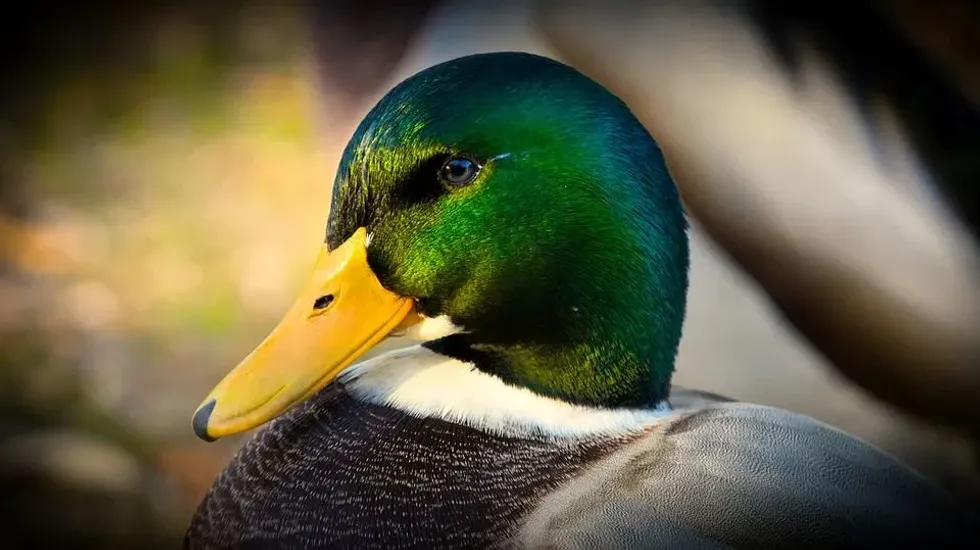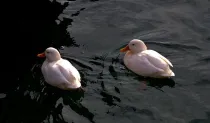Fun Domesticated Duck Facts For Kids
Quack-Quack! Hearing the sound, you can quickly identify it's a beautiful duck, and it may immediately remind you of the two most famous ducks Donald and Daffy, which are pretty well-known cartoon characters to all ages. Here in this article, you can find more interesting facts about them.
Domesticated duck is a generic term given to all ducks that are being farmed for specific purposes like meat production, egg production, exhibition purposes, as ornamental birds and pets. The scientific name for these duck breeds is Anas platyrhynchos domesticus. The Latin word platyrhynchos means flat-nosed, which is the shape of the duck's bill.
Ducks have been first domesticated at least 4000 years ago in Southeast Asia. They are a lot of different breeds of domestic ducks out there. A duck can be easily identified as domestic or wild based on its striking differences in color, size in breeds of domesticated duck.
Do you like to read more interesting facts about domesticated duck breeds? Here you can find some unknown facts about this breed. Also, check our other articles on similar species like geese and African pygmy geese.
Domesticated Duck Interesting Facts
What type of animal is a domesticated duck?
A domesticated duck is a familiar and widespread bird, also called a waterfowl, because they are natural water lovers and live near ponds, rivers, lakes, and even oceans. Like most other domestic poultry species, the domesticated ducks have many breeds and are descendants of the wild Mallards except the Muscovy duck.
What class of animal does domesticated duck belong to?
Domesticated duck species belong to class Aves, in the family Anatidae. They are close relatives of geese and swans, which belong to the same family.
How many domesticated ducks are there in the world?
The exact data on the number of domesticated ducks in the world is unknown as there are a variety of duck breeds found throughout in abundance.
Where does a domesticated duck live?
Domestic ducks are spread around the globe except in Antarctica. Some ducks live in the tropics, while others live in temperate climates.
What is a domesticated duck's habitat?
Domestic ducks are known as waterfowl because of their habitat near rivers, ponds, lakes, wetlands, and streams. They are widely distributed through many habitats like public parks, farmlands, pastures, poultry, etc.
They are found in the urban and semi-urban natural grassy areas near water bodies. Sometimes they sleep in a nest made in tall grass near a pond or sleep while floating on the pond. They do not feel cold, and so any structure with ample ventilation is ideal for them.
The pen/housing has to be covered with a layer of straw for bedding and nesting purposes. They do not shy away from rain and enjoy moving in the rain.
While a pond is optional, a small pool or tub is also suitable for these ducks to submerge their bodies. They are also raised in poultry with enclosed structures to prevent threats from foxes, dogs, etc.
Who does domesticated duck live with?
Domesticate ducks are social creatures and live in small to large groups. They are kept together in large numbers in poultry.
These breeds are friendly and also go well with other animals on a farm. A flock, a team, a raft, or paddling are all terms used to describe a group of ducks. These breed ducks spend their days looking for food and sleep together with their paddlings at night.
How long does a domesticated duck live?
Domesticated duck breeds have an average age of up to 10 years in captivity. Therefore, they are not long-lived as geese but can improve their age for longer years with proper care and a good diet. However, it's a fact that wild ducks have an average life span of around 20 years or more.
How do they reproduce?
Domestic ducks have a different breeding season for different breeds, from late winter to early summer. The duck species are monogamous for a breeding season. However, they don't typically mate for life and seek new mates every breeding season.
Male ducks fertilize eggs through copulation with female ducks. Males must mate with females once every four to five days to ensure fertilization. After a courtship ritual during mating season, copulation occurs like mammals.
Female ducks construct their nests with nesting materials, including grass, mud, twigs, leaves, reeds, and other plant material. To offer their eggs the maximum possible comfort and insulation, they will line the nest with soft down feathers plucked from their breast. Due to this plucking, their skin exposes, which keeps the eggs warm more efficiently.
After preparing the nest, the female ducks lay about 12 eggs per clutch, depending on the breed. The domesticated duck egg is blue-green to white, depending on the breed.
It takes about a day for all the eggs in a clutch to hatch. Immediately after hatching, the mother duck leads their young to the water within hours and do not have to feed.
What is their conservation status?
The conservation status of domesticated ducks is Not Evaluated as they are bred as poultry and are widespread across the continents.
Domesticated Duck Fun Facts
What does a domesticated duck look like?

Ducks generally have an elongated and broad body with distinguishable features like a slim head, broad bill, and a long neck. The body shape and color of domestic ducks vary among different breeds.
They have wide webbed feet and short legs for efficient swimming and walking. The breed has strong wings with long feathers, and the birds come in different colors.
The body and head plumage may be white, grey, brown, black, buff, green, purple, silver, blue, or a combination of them which depends on different duck breeds.
For example, a male Cayuga duck has iridescent green feathers. However, a female Cayuga has less apparent iridescent green plumage. A white Pekin has large white color feathers, orange-yellow bill, reddish-yellow shanks, and feet. The khaki Campbell male is khaki colored with usually olive-green head. In contrast, the khaki Campbell duck has khaki plumage covering the whole body.
How cute are they?
The domestic duck is a cute and handsome bird. They were used as ornamental birds or as a pets. Some ducks are bred purely for show. They have beautiful plumage and decorative tufts. The breed, like buff Orpington, is one of the show birds.
How do they communicate?
Domestic ducks make a wide range of calls, ranging from whistles and cooing to yodels and grunts. Although their calls are not loud, they are made to alert other ducks of nearby threats, or during courtship, the male makes a softer call by exhibiting their beautiful feathers in a display and preening each other with the bill.
Call ducks are the smallest domesticated duck breeds raised originally for hunting or as pets and known to have the loudest call.
How big is a domesticated duck?
The domestic duck's size depends on its breed. A domesticated duck is generally 20 in (50 cm) long and 24 in (60 cm) tall (from the base of neck to tail).
Thus, it is larger, bulkier, and twice the size of a wild Mallard. The largest domesticated duck is the Muscovy breed living in North America. It grows to be around 30 in (76 cm) long and weighs about 15 lb (7 kg).
How fast can a domesticated duck move?
The domesticated duck breeds are intentionally bred to be heavier so that they do not fly away and so they do not fly high. These breeds flock in V- shape, and birds take turns to lead the flock. They walk or run at a speed of 8.2 mph (13.2 kph).
How much does a Domesticated Duck weigh?
Their weight very much varies based on the different breeds of domestic ducks. On average, a female Muscovy duck weighs 6-8 lb (2.7 - 3.6 kg), and a male Muscovy duck weighs 10-15 lb (4.6 - 6.8 kg).
On the other hand, a female Indian runner duck weighs 3-4.4 lb (1.4 - 2 kg), and a male Indian runner duck weighs 3.5-5 lb (1.6 - 2.3 kg). Thus, the mallards are slightly heavier than most other domestic ducks, which weigh between 1.5-3.5 lb (0.7-1.6 kg).
What are the male and female names of the species?
An adult male domestic duck is called a drake, and an adult female duck is called a hen or a duck.
What would you call a baby domesticated duck?
Baby ducks are called ducklings. The generic term chick also applies to ducks.
Ducks are precocial, which means that the ducklings require relatively little parental care and are able to walk just a few hours after hatching. This natural behavior helps to protect the young ducklings from predators since they don't need to stay in the vulnerable nest area for long.
What do they eat?
Domestic ducks are omnivorous. This breed eats a variety of food like leafy vegetables, cord, seeds, grain, berries, including aquatic vegetation such as pondweed, insects, worms, small water snails and amphibians, and even crustaceans such as crayfish.
Are they poisonous?
No, domestic ducks are not poisonous and are consumed by humans.
Would they make a good pet?
Domestic ducks, also known as waterfowl, are great and enjoyable to have in the house garden. These ducks are affectionate and friendly with humans, mostly making them good pets and companions. In contrast, wild ducks are shy and stay away from people.
Some domestic duck breeds are specifically farmed to keep as a pet like white Pekin duck, runner ducks, Cayuga, khaki Campbell, buff Orpington, and Swedish blue. Of these breeds of ducks, the Swedish blue is the beautiful, calm and friendliest bird.
An old dog house, chicken coop, pen, or small shed is enough to lock the ducks at night to protect them from attacks.
Did you know...
Did you know that a duck is said to lay over 250 eggs per year?
Domestic duck breeds are classified into different classes throughout the world by their size, and weight, like bantam, light, medium, and heavyweight.
A wild mallard was once struck by a jet plane over Nevada at an altitude of 21,000 feet (6,400 meters), the highest recorded flight of any duck!
Ducks have waterproof feathers due to a gland at the base of the tail produces the waxy oil that's spread on each feather.
Domestic ducks bred for food are either too heavy or have their wings clipped to prevent them from flying. As a result, they fly for short distances. However, wild ducks like mallards do fly and can migrate long distances.
The white Pekin is considered the most popular commercial duck breed in the US. However, the white Pekin bird bred in China is primarily farmed for meat and egg production.
The females of most breeds of domestic ducks are unreliable at sitting on their eggs for raising their young. However, the Rouen duck and especially the Muscovy duck are exceptional.
So, the duck eggs are put under broody hens for hatching, and it has been a custom on farms for centuries. Nowadays, it is done by an incubator in poultry.
Magpie ducks are light-class birds, which are rarely ever raised for their meat.
A duck egg is richer in Omega-3 fatty acids than a chicken egg. Also, duck meat is nutritional and higher in iron content than chicken.
Are they predators?
No, they are not predators. They are omnivores birds and eat insects, fruit, seeds, algae, small fish, and crustaceans that are abundantly available in their habitat.
However, adult ducks can fall prey to various animals, including snakes, possums, falcons, hawks, and raccoons. Ducklings are also eaten by animals like large fish, crocodiles, and herons. But, being fast swimmers helps them to escape a threat.
What is the difference between domesticated duck and goose?
Though geese and domesticated ducks belong to the same Anatidae family, there are a bit differences between them.
A goose is also a type of waterfowl but is larger than the domestic duck breed. They have a longer neck and a more elongated body. Also, the webbing of the feet is more prominent in geese.
Geese have short notch beak compared to duck breed, whose beak is broad and flat.
Geese are herbivores, while domestic duck breeds are omnivores.
Geese communicate through honking sounds, and the domestic duck breed communicates through quacking.
Here at Kidadl, we have carefully created lots of interesting family-friendly animal facts for everyone to discover! Learn more about some other birds from our harlequin duck facts and leghorn chicken facts pages.
You can even occupy yourself at home by coloring in one of our free printable domesticated duck coloring pages.
We Want Your Photos!
More for You
See All
Bachelors in Business Administration

Aashita DhingraBachelors in Business Administration
Based in Lucknow, India, Aashita is a skilled content creator with experience crafting study guides for high school-aged kids. Her education includes a degree in Business Administration from St. Mary's Convent Inter College, which she leverages to bring a unique perspective to her work. Aashita's passion for writing and education is evident in her ability to craft engaging content.
Disclaimer
1) Kidadl is independent and to make our service free to you the reader we are supported by advertising. We hope you love our recommendations for products and services! What we suggest is selected independently by the Kidadl team. If you purchase using the Buy Now button we may earn a small commission. This does not influence our choices. Prices are correct and items are available at the time the article was published but we cannot guarantee that on the time of reading. Please note that Kidadl is a participant in the Amazon Services LLC Associates Program, an affiliate advertising program designed to provide a means for sites to earn advertising fees by advertising and linking to Amazon. We also link to other websites, but are not responsible for their content.
2) At Kidadl, we strive to recommend the very best activities and events. We will always aim to give you accurate information at the date of publication - however, information does change, so it’s important you do your own research, double-check and make the decision that is right for your family. We recognise that not all activities and ideas are appropriate for all children and families or in all circumstances. Our recommended activities are based on age but these are a guide. We recommend that these ideas are used as inspiration, that ideas are undertaken with appropriate adult supervision, and that each adult uses their own discretion and knowledge of their children to consider the safety and suitability. Kidadl cannot accept liability for the execution of these ideas, and parental supervision is advised at all times, as safety is paramount. Anyone using the information provided by Kidadl does so at their own risk and we can not accept liability if things go wrong.
3) Because we are an educational resource, we have quotes and facts about a range of historical and modern figures. We do not endorse the actions of or rhetoric of all the people included in these collections, but we think they are important for growing minds to learn about under the guidance of parents or guardians.







